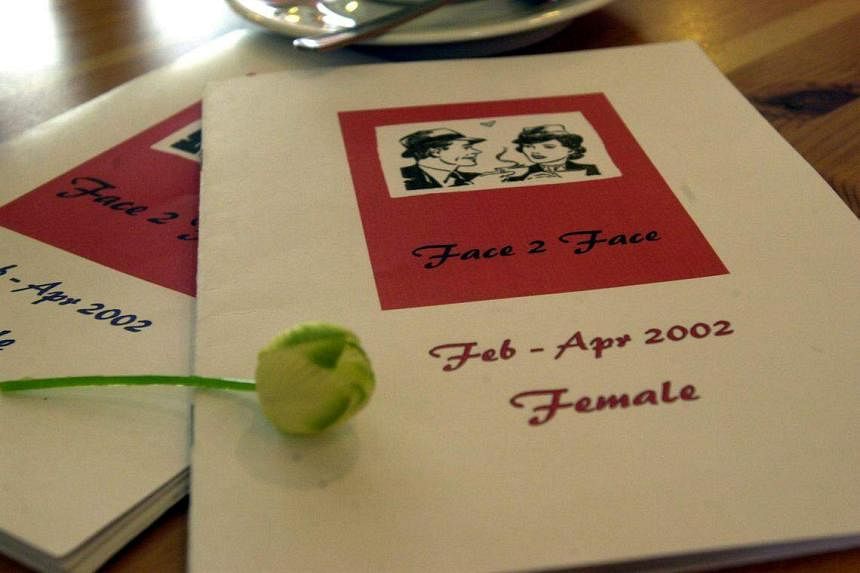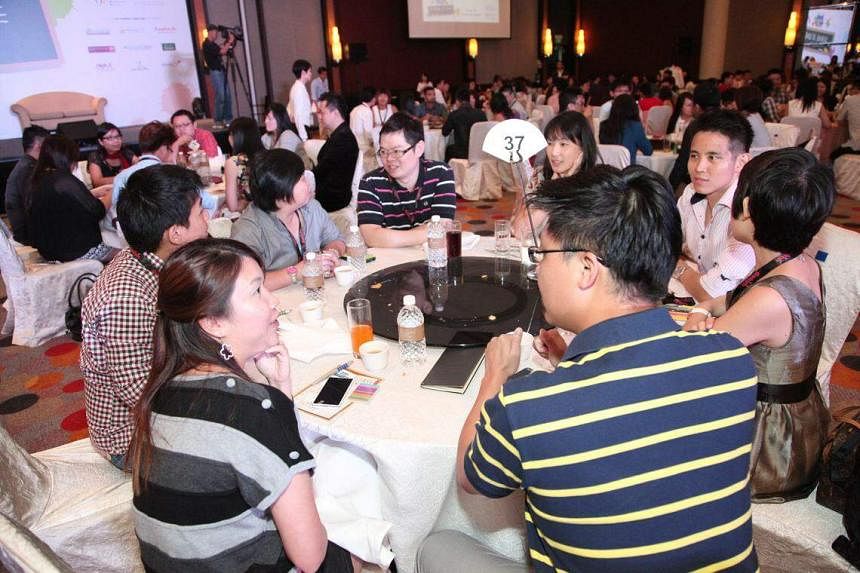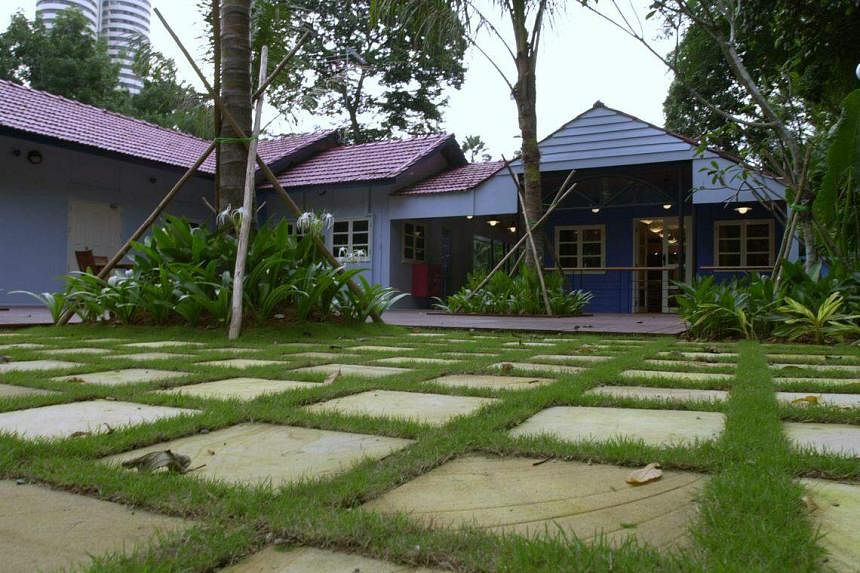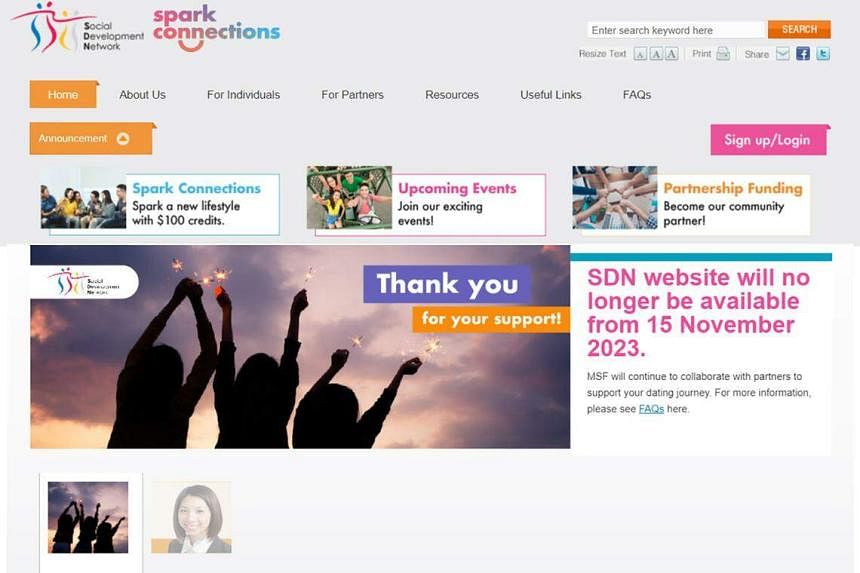SINGAPORE - Like two ships passing in the night, Mr Seah Wei Chuan and Ms Ding Ying Yian would never have hit it off – but for the Social Development Network (SDN).
Both introverts and aged 32 then, with zero common interests, they met at an SDN-organised tea appreciation event in 2011.
Mr Seah was immediately attracted to Ms Ding, and e-mailed her afterwards to meet up. Ms Ding thought “he seemed like an ordinary guy, nothing very special” – but she decided to give him a chance.
In April that year, within two months of their first meeting, Mr Seah proposed. In October, they were married.
Theirs is one of thousands of successful matches by the SDN, the modern-day incarnation of the Social Development Unit (SDU) set up by the Government in January 1984 with an initial mission of coaxing graduates to marry – and have children.
But as it approached four decades of helping Singaporeans find love – sometimes amid controversy, even derision – the agency known to many as the national matchmaker will no longer be focused on social interaction initiatives.
In November 2023, it quietly shuttered its website, after having sent an e-mail to members a month earlier, thanking them for their support.
SDN’s Web address now points to a one-sentence write-up on the Ministry of Social and Family Development’s (MSF) website that it “works with partners in the private, people and public sectors to promote a conducive landscape for singles to meet and form meaningful relationships”.
Responding to queries, MSF said SDN saw declining membership over the years, though it did not provide figures.
It pointed to how there is currently a range of alternatives offered by the private sector, compared with 2012, when the SDN started its website and worked with dating agencies and merchants to facilitate social interaction. “Today, there are better alternatives offered by the private sector, including online dating apps,” said a ministry spokeswoman.
SDN will thus be pivoting to focus on supporting singles in other ways, such as with skills to build stronger relationships, said the spokeswoman.
“We need a whole-of-society effort to make Singapore more family-friendly and conducive for singles to achieve their marriage aspirations alongside other life goals,” she added.
Incentivising romance
The genesis of the SDN can be traced to the 1983 National Day Rally, when then Prime Minister Lee Kuan Yew warned that the country’s talent pool would dwindle unless better-educated Singaporeans got married and had more children.
After two decades of successful family planning, the 1980 population census showed an increasing proportion of unmarried graduate women. Among them, those who did tie the knot had fewer children than those who were less educated.
In this milieu, the rally birthed the Graduate Mothers Scheme – a policy to give the children of such mums priority for school admission – and a $10,000 sterilisation cash grant for low-income mothers.
The scheme divided both Cabinet and public opinion, and was scrapped a year later, while the grant saw few takers in the years that followed.
That vocal opposition to the programmes did little to convince the Government to modify them contributed to the 12.8 point swing against the PAP in the 1984 General Election, political observers such as then National University of Singapore associate professor Chan Heng Chee wrote in The Sunday Times (ST).

While the launch of the SDU in 1984 did not attract as much public attention as the two programmes, it was nonetheless controversial as it was meant for only university graduates.
Eighteen months after it was spun up, the unit said close to 4,900 people from the public sector had joined its activities, while six couples had tied the knot.
Later in 1985, partly in response to charges of elitism, the Social Development Section (SDS) was set up for singles with O-level qualifications. In 1990, the Social Promotion Section was created for singles who had not completed secondary education.
Both sections were combined in 1995 to form the Social Development Service for all non-graduates. It would be another 14 years before the graduate/non-graduate distinction would be erased.
In 2006, the SDU announced that it would shift from playing Cupid itself to accrediting private-sector dating agencies and matchmakers.

It was a bid to get members of the public to trust such organisations, and to erase the stigma of being “matchmade by the Government”. A news article that year said 42,000 singles had been successfully hitched through the SDU’s efforts since 1984.
A government trustmark which provided a professional framework for dating agencies in Singapore was then rolled out in 2007. In 2009, the SDS and SDU were merged and rebranded as the SDN, removing the education qualification criteria and broadening the dating pool.
Several iterations later, the SDN website was created in 2012. It became a one-stop platform for singles to connect, discover events for social interaction and pick up information on dating and relationships, before it became defunct in 2023.
‘That stigma wouldn’t shake’
SDN’s journey has been bumpy for a number of reasons.
Despite numerous attempts at reinvention, it had long been plagued by the stereotype that people who use its services must be “single, desperate and ugly”, a play on the old SDU abbreviation.
Sociologist Paulin Straughan noted that in her career, she has met couples who told her that they had met through the SDU, but did not want their success stories to be “outed”.
“This makes the SDU a very interesting product where the satisfied customers are too shy to come out and say they use it,” she said. “That stigma wouldn’t shake, even after they tried to rebrand it.”
The unit’s funding of university orientation camps in the 2000s, which made the news for their risque games conducted in the name of icebreaking, angered the public. SDU said then that it did not approve of such games, and that camps that did not comply risked having their funding retracted. It ceased funding of university camps and events in 2016.
Despite SDN’s gradual shift from overt matchmaker to indirect nudging through funding support for private outfits, Singaporeans still chafed at its initiatives they felt were heavy-handed.
For instance, its 2012 push to get family and friends of singles to buy them dating vouchers – available in $10 denominations, and good for events and services offered by accredited dating agencies – had some darkly worrying they would receive the so-called “love gifts”, instead of cash, in their Chinese New Year hongbao.

Controversies aside, SDN’s raison d’etre of getting Singaporeans hitched and raising the birth rate can only be described as Sisyphean, in the face of long-term demographic trends.
The country’s fertility rate sliding to new lows – it fell below 1.0 for the first time in 2023, after previous records of 1.04 in 2022 and 1.12 in 2021 – and climbing singlehood rates would spark news reports and commentaries, inevitably throwing into question SDN’s effectiveness.
“Government matchmaking programmes need a rethink to get singles to mingle,” proclaimed one headline in 2018, after that year’s Population in Brief report noted that the biggest increase in singles was among Singaporean women aged 25 to 29.
Mainstreaming matchmaking
For all the brickbats, observers said SDN played a pivotal role in nurturing a nascent professional dating scene and socialising Singaporeans to the use of dating services and matchmaking, years before the first dating apps appeared.
Back in 2006 when it became an accrediting body, private dating services were not getting the kind of recognition and trust they get today from potential clients.
Accreditation by a government agency was a stamp of trust, sending a signal to Singaporeans that they were not dealing with a fly-by-night operation. Nor would they encounter “hanky-panky”, said Prof Straughan, who is also dean of students at Singapore Management University.
Service providers received support through the years to grow. Co-founder Violet Lim of dating agency Lunch Actually said SDN funding through its Partner Connection Fund allowed the firm to innovate and scale its services. So did dating app company Paktor, for which subsidies helped it develop its systems and launch marketing campaigns to reach more singles.

The SDN also allowed accredited dating agencies to screen their client databases against the Registry of Marriage’s records, noted Mr Alex Tam, chief executive of Paktor, which owns dating agency GaiGai. “This was useful for our company to verify the marital status of all our clients to prevent inaccurate client disclosures,” he added.
Besides raising industry standards, SDN funding also helped raise demand for such services by the public.
For instance, it distributed $100 worth of dating credits yearly to encourage singles to meet. The credits, which could be used to offset up to half of ticket costs for approved dating events, increased the take-up rates of dating events organised by accredited agencies, said Mr Tam.
Through subsidies and extensive marketing and public outreach, SDN lowered the barriers for singles to try out dating services and personalised one-to-one matchmaking services, while promoting the importance of healthy relationships, marriage and family building, he added.
“There were definitely many couples and marriages that were formed through all these campaigns and efforts in collaboration with partners and agencies,” he said.

What’s next for SDN?
As with Netflix to cinemas, and other technology-mediated disruptions, the rise of online and app-based dating played a key role in the SDN’s declining relevance.
A 2021 National Population and Talent Division survey found that among singles who were currently dating, the proportion who met through online channels had grown from 7 per cent in 2012 to 29 per cent in 2021.
Across the same period, the proportion of those who met at school, at work or through friends all fell.

While one in five in the 2012 survey said they were comfortable meeting via online dating sites or apps, the figure jumped to nearly three in five in the 2020 survey.
SDN’s shift to focus on relationship skills is therefore not surprising, said experts that ST spoke to. Marriage counsellor Theresa Pong said today’s young singles are navigating a season of adulting while having grown up in a digital world.
One skill she sees as lacking is knowing how to interact and communicate face to face, said the director at The Relationship Room, a relationship counselling provider.
“They are doing everything digitally, which takes away the essence of relationships and marriages, which are all about everyday face-to-face interaction,” she said.
Other vital skills include learning to form healthy boundaries, said Ms Pong, who pointed at circumstances like open relationships and situationships – non-committal entanglements – as potential issues that can cause emotional wounds.
Prof Straughan added that the norms of social interaction have also evolved, and that young singles may find it useful to have guidance on when and how to seek consent, to build lasting relationships grounded on respect.
Empirically, there also appears to be a growing need to hone younger Singaporeans’ conflict management skills, they added.
Ms Pong pointed to statistics released in 2023 which showed that the highest proportion of break-ups come between the fifth and 10th years of marriage.

Today’s couples have to contend with more areas of potential conflict, such as financial independence or squaring interfaith and inter-ethnic differences, said Prof Straughan. For instance, compared with when the SDN was first set up in 1984, the proportion of inter-ethnic citizen marriages has tripled to 17 per cent in 2022.
Ms Pong suggested that the Government consider coming up with the relationship equivalent of regular health checks, so there is greater success navigating each life stage from singlehood to dating and into marriage.
While conventional wisdom is that young people are all about dating apps, especially in a compact city-state like Singapore, Prof Straughan said it is wrong to assume that there is no longer a need to help connect young people with potential life partners.
A role the SDN could fill going forward is to create more social spaces for young adults with mutual interests to go where they feel safe and welcome, she said.

This could be as simple as a karaoke room, like the one where love first blossomed between Ms Ding, an engineer, and Mr Seah, who works in IT support.
Ms Ding loved karaoke, and despite not being a crooner himself, Mr Seah felt his heart leap each time he heard her sing. “I was her audience of one,” he quipped.
“When I met Ying Yian, I realised she is the one for me. We have an unconventional dating journey, but once you’re comfortable with one person, time doesn’t really make a difference,” he added. “And now, it’s been 12 years.”
They have two sons, aged 10 and 12.


